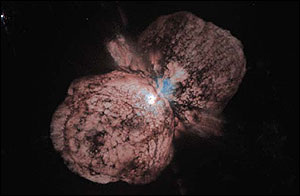The theory of the death star of Prof. Arnon Der of the Technion is causing echoes in the world
Avi Blizovsky

Sooner or later, a catastrophe could wipe out almost all life on Earth. The few who might survive might want to die as they have to scramble for resources of an almost dead planet.
According to Dr. Arnon Dar, from the Asher Institute for Space Research at the Technion, says that a certain type of exploding star may collapse in the space environment close to us, and hit the Earth. Dr. Ruin to many scientific journals, and was also quoted in the popular media which were not always accurate in his words.
Using the latest data and calculations, he claims that supermassive stars that will explode in their lifetime and become a black hole will send out a beam of destructive radiation and particles that will dislodge every planet in the beam's orbit.
The chance for any planet in our galaxy to be affected by such an event is one in a hundred million years. "This is the appropriate timetable for the series of massive extinctions that occurred in the geological history of the Earth." says Dr. Dr.
A super massive star, those whose mass is ten times or more than that of the Sun are scattered throughout the galaxy. When they explode near the end of their lives they emit a massive beam of radiation, known as gamma rays, into space. These gamma rays are so powerful, and together with the energetic subatomic particles that come in their wake, can affect life in our galaxy.
If such a beam were to hit the Earth, the effect would be absolutely devastating, unlike anything else we can imagine, says Dr.
On the side of the Earth facing the explosion the shock waves will begin to roll through the atmosphere, igniting fires as they reach the ground. Within minutes the radiation wave from deep space also arrives, the temperatures in the atmosphere will begin to rise rapidly, wreaking havoc on the entire global weather system. All organic matter on the surface of the earth will begin to burn. The survivors will be the ones who hide in caves and buildings. But the worst is yet to come.
The attack of the first gamma ray will last a fraction of a second. Immediately after, the cosmic rays will arrive that will make a name for the earth for days. There will be no hiding from them.
Cosmic waves are highly energetic particles that move through space at almost the speed of light. They collide with particles in the atmosphere, causing the release of energy and creating a variety of destructive sub-particles. These particles, called muons, will penetrate hundreds of meters into rocks so that very few caves will be used to offer protection and even creatures living on the seabed will be affected by the huge amounts of radiation.
Earth's ecosystem will be destroyed. "The few who survive may want to die," says Dr. "They will fight in the literal sense of the word on a dying planet.
Dr. Dar points to the possibility that most of the extinctions that have occurred in the history of the earth were caused by the influence of harmful radiation from space. No direct proof has been found so far," he says. But adds that the scientists are looking for these proofs.
And there is also good news. Because gamma-ray bursts from exploding supermassive stars are shot across the universe in narrow beams, no more than a meter wide, most of them miss Earth. However, recent statistics show that once in a hundred million years, we will not be so lucky. Oddly enough, this is roughly the rate of mass extinctions on Earth.
At this point the astronomers do not know which star to look at. Stars such as the supermassive star Eta Carinae in the Southern Hemisphere sky are among the stars that may explode and emit gamma rays at some point in the next million years. However, this specific star is not facing us.
Without a doubt, there is such a star, but the astronomers have not yet found it, but even if they do, can we get any kind of warning? Not with our current understanding of science, says Dr. Derr, but science is progressing and maybe one day we will be able to discover the threatening stars.

One response
These things are not known since today and there is nothing new under the sun (or in this case, under the supernova). With all due respect to Dr. Derr, it seems to me that attracting media attention was on his agenda.